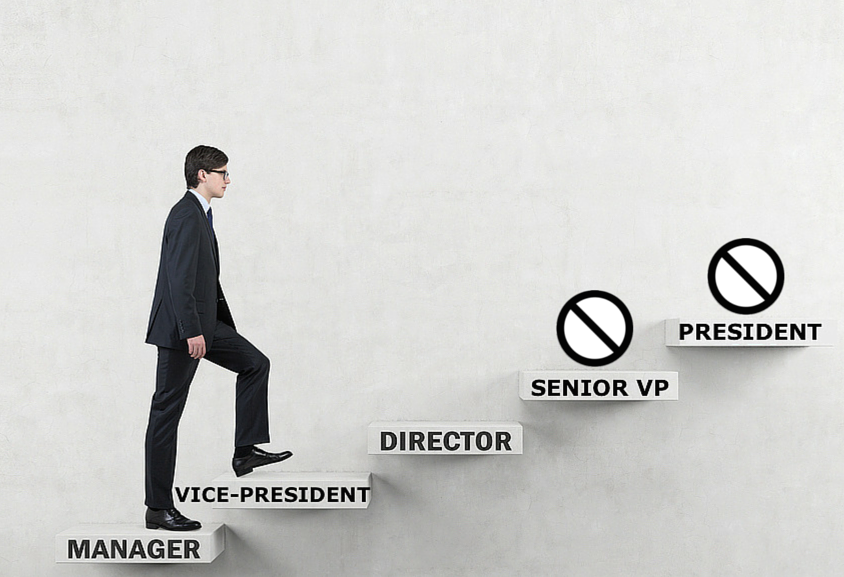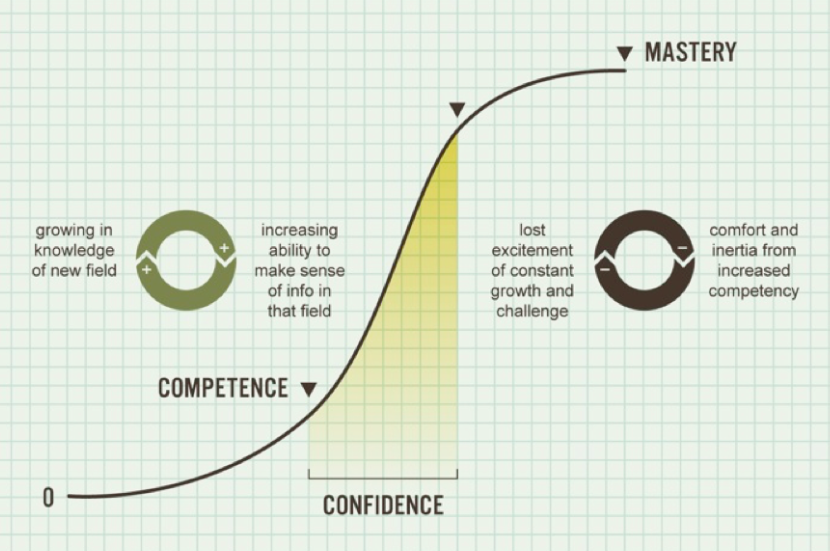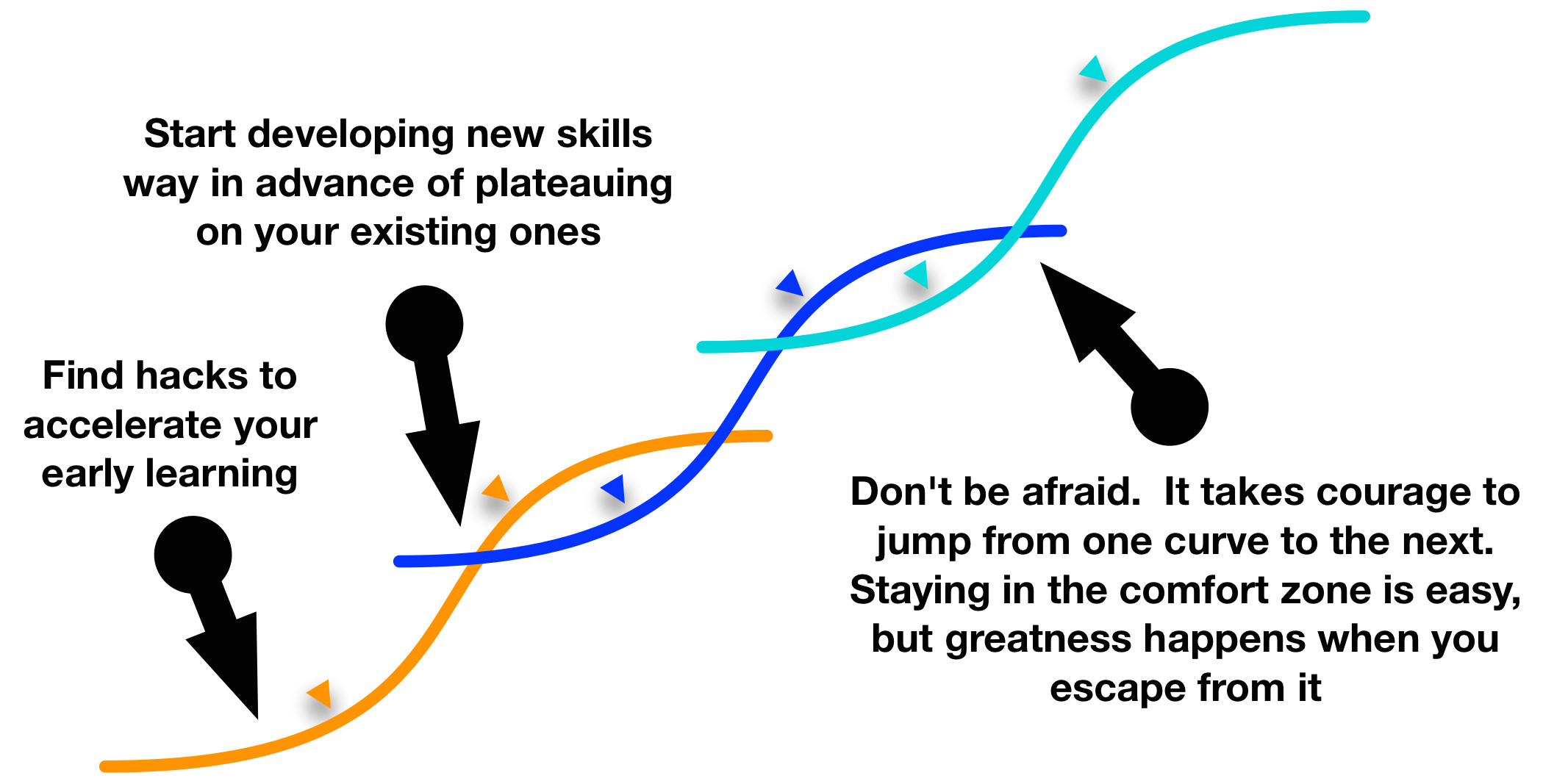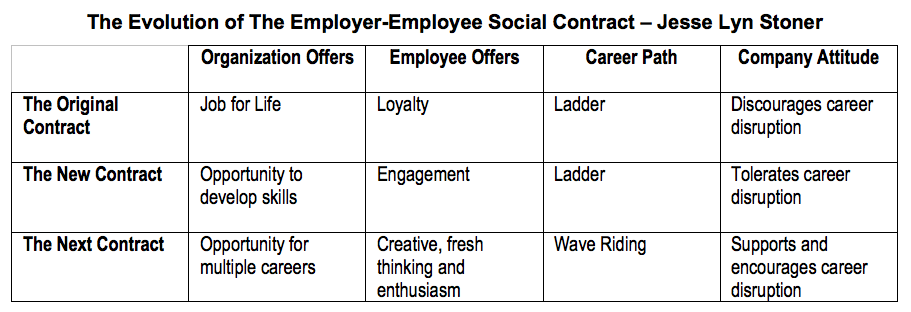 Traditionally, career paths have been based on the idea of “moving up the ladder.” Success is measured by how high you get. A lateral move is usually not seen as a smart career move. Even when changing jobs to increase your skills, the expectation is the new position will be a step higher up the ladder.
Traditionally, career paths have been based on the idea of “moving up the ladder.” Success is measured by how high you get. A lateral move is usually not seen as a smart career move. Even when changing jobs to increase your skills, the expectation is the new position will be a step higher up the ladder.
The idea is to keep moving up until you’ve gone as high as you can. At that point, you have reached your “career peak.” Depending on your age, you might be hanging out at your peak for a long time.
And that can be a problem for both the employee and the company. Whitney Johnson, author of Disrupt Yourself: Putting the Power of Disruptive Innovation to Work, advocates for career disruption, not career ladders. According to Johnson, when people reach their career peak, they start to stagnate and become bored. They lose interest because maintaining is not as much fun as building toward something. Their creativity in problem-solving ability decreases because their thinking becomes habitual.
Her book made me wonder what’s really behind the “Peter Principle.” Maybe it’s not just a matter of promoting people to their level of incompetence. Perhaps they become incompetent because they are stagnating.
Career disruption is the new normal.
I had the privilege of speaking with Whitney Johnson to explore the implications of what she calls personal disruption for organizations.
Her newest book, Disrupt Yourself, shows that the journey to mastery follows an S-curve, where the enjoyment of mastering a new field of knowledge wanes as you become more competent, and your openness to new ideas wanes as your thinking becomes more automatic.

Johnson says, “To avoid stagnation and to fast-track your career and personal growth, you should be thinking about changing careers every three years.”
 This means a career path should look like a series of S-curves, or waves. Instead of a straight path up a ladder, we should be thinking of career development as “wave riding.”
This means a career path should look like a series of S-curves, or waves. Instead of a straight path up a ladder, we should be thinking of career development as “wave riding.”
According to a 2012 Future Workplace Study, 91% of Millennials expect to stay in a job for less than three years, and Fast Company reported a study pointing toward 4-year careers. In a recent Forbes article, Face It, Career Jumps Are the Future of Work, Meghan Biro concludes, “career mobility should be seen as a given.”
Are our organizations prepared for career disruption?
According to Whitney Johnson, “We need to harness the power of disruption to create organizations where innovative ideas take root.”
But how prepared are our organizations to deal with disruptive career development, let alone to harness its power?
Career paths are based on the traditional notion of a career ladder. Pay increase and prestige are based on upward movement. And career development programs are based on preparing people to move upward.
As more and more people disrupt their careers, organizations will be facing a revolving door of top talent, resulting in a loss of organizational memory and people who understand the vision and strategies.
And that will be very bad news for organizations. . . unless, a fundamental shift in the employer-employee social contract occurs.
The Employer-Employee Social Contract
The original contract, which governed most of the 20th century, was that in exchange for loyalty, the company would provide a job for life. However, toward the end of the 20th century, as a result of periods of downsizing where companies could no longer promise a job for life, the contract no longer held up.
In the 1990’s a new contract emerged – that in exchange for a full effort and engagement while part of the company, the company would offer the opportunity to increase skills that could be transferred to one’s new company. But the Gallup engagement studies have clearly demonstrated the new contract no longer works, if it ever did.
In today’s increasingly complex world, where creativity and innovation are the seedbeds of growth, organizations need employees who are attuned to fresh thinking, not those whose thinking has become automatic. This means that the most valuable employees are those who are approaching the top of the S-curve, but have not yet settled at the top of their career ladder.
If Johnson is correct, instead of simply tolerating career disruption, organizations will need to support and even encourage it, which calls for a different contract.
The next contract needs to be that in exchange for creativity, fresh thinking and enthusiasm, the company will provide an abundance and variety of learning experiences and career opportunities.

Disrupt your organization’s career path.
How should organizations support and encourage career disruption? What does the next contract actually look like in practice?
Megan Biro says, “The key for tackling it going forward is to not try to outmaneuver it. Instead, it’s going to be offering far more opportunities to express ambition within the context of the same organization; to change the status quo.” I completely agree with her, and I wonder if simply offering more opportunities will be enough.
It seems to me that organizations need to disrupt the career path itself – to throw everything we think we know about development out the window. We need to bring creative, fresh thinking, starting with questions like these:
-
What kind of jobs can we offer that are meaningful, and that give employees an opportunity to make a contribution and to maximize their potential?
-
How does our thinking need to change? What would it mean to change from thinking about “career paths” to “career opportunities?”
-
How can we change our norms and beliefs to view frequent job change as desirable?
-
What kind of pay structure would reward multiple skills rather than hierarchical position?
-
What job titles would reflect what people do rather than reinforce the importance of hierarchical position?
-
How can we offer clear career choices that support employees in taking charge of their own development?
Creating a new way of understanding and providing career opportunities is the only way we’ll be able to create organizations where innovative ideas take root and to ensure our organizations maintain a critical mass of talent who are performing optimally.
The challenges in making the changes called for might seem risky, but the bigger risk is doing nothing and waiting until there is no choice.
* * * * * * * * * * * * * * * * * * * * * * * * * * * * * * * * *
 I wrote this article in honor of my friend and colleague Whitney Johnson’s wonderful new book, Disrupt Yourself: Putting the Power of Disruptive Innovation to Work. Not only is her book helpful for individuals as they consider the multiple careers they are likely to face, but it is also helpful for leaders who want to drive corporate innovation through personal disruption. Johnson co-founded Rose Park Advisors, an investment firm with Clay Christensen, is a frequent Harvard Business Review contributor, a successful author and was named one of the top 50 most influential Management Thinkers by Thinkers50 in 2015.
I wrote this article in honor of my friend and colleague Whitney Johnson’s wonderful new book, Disrupt Yourself: Putting the Power of Disruptive Innovation to Work. Not only is her book helpful for individuals as they consider the multiple careers they are likely to face, but it is also helpful for leaders who want to drive corporate innovation through personal disruption. Johnson co-founded Rose Park Advisors, an investment firm with Clay Christensen, is a frequent Harvard Business Review contributor, a successful author and was named one of the top 50 most influential Management Thinkers by Thinkers50 in 2015.













Jesse, your blog reminded me of my 27 years in the former Bell System.
In my first ten years, I had nine jobs, keeping me on a constant learning curve – or wave-riding 20th-century style. We didn’t need to change companies to experience career disruption – such disruptions were inevitable. The “original contract” allowed for investment in employees for long-term dividends. Perhaps the “Next Contract” will provide similar experiences but 21st-century style.
Great point about investing in employees for long-term benefit. Perhaps part of the shift back will come from the necessity to recognize the value of people as human beings, not simply human resources. Thanks for your insights, Fay!
I wonder about building trust between employees and the company in the new contract you speak of. In the middle developmental model, the employee knew they could take with them the skills the company paid for and provided. When there was no loyalty and pension at the end of the rainbow, that had some balancing effect along with the moveable 401K plans. I am retired now but it seems that young people in the work place are very stressed. How will they manage changing jobs and careers every 3 years? That’s a lot of transition time in a short period. You raise interesting questions about the future.
Career disruption is an option for those who are attracted to it, but not a requirement. Although research shows that more and more people are choosing it. The world has changed a lot since early boomers joined the workforce. There has been a movement toward less dependency and assuming responsibility for many things where services used to be provided (secretaries to type letters, travel agents to make reservations, gas station attendants), and with the advent of the Internet, it has become even more direct through vehicles like Airbnb, Uber, Square, etc. Employees are directly in contact with prospective employers and mobility is so much more possible.
How will organizations need to change to respond to this? All organizations will need to be serious and intentional about providing development opportunities. There will need to be creative, non-hierarchical career paths within organizations to entice employees to stay. And attitudes will need to change e.g. There will need to be a radical acceptance of fluidity in employee movement within, through, and between organizations, even to and from competitors.
I appreciate your concern for young people today. Indeed, it is a very different world now – in some ways more free, but also more complicated. Much thanks for deepening the conversation, Marye Gail!
Oooh! I love the thoughts this post creates.
Thank you for merging wisdom and questions from Whitney, Meghan and from you.
This would make for an energizing and fascinating dialog!
Yes, much to think about, Chery. Whitney challenged me to think about the implications for organizations, and I ended up spending three months thinking and working on this piece. Definitely worth a dialogue. Would love to know what strikes you on first thought.
Jesse = thank you for your gift of tuning into the trade winds of change and letting us experience their global power in increments that we can digest and integrate into our personal understanding of our own lives and of the lives of our families, colleagues and clients.
Thanks so much for your kind words, Ira. That is indeed my goal.
It’s interesting to think of small, underfunded non profits being on the leading edge. My experience in the community mental health system had me getting a new job often several times a year. There would be the opportunity to write a grant and then to staff it through its initial months. Then there would be key people who left and a vacancy that had to be filled at least temporarily. I even ended up supervising all the fiscal and HR folks for a while. In 25 years there, I never got bored and was always learning something new.
Great point, Betsy. There is much that the business world can learn from the non-profit world. Although, I do know many non-profit executive directors who have been in position for 25 plus years and wish they could retire, but can’t for financial reasons. They lack the enthusiasm and flexible thinking of their early years. And younger leaders are missing out on the opportunity to develop. A comprehensive study in 2011 by Dare to Lead noted this issue and the Center for Creative Leadership discussed this issue in their 2012 annual report.
A perfectly great piece with so many ideas about how to stay resilient and forward=moving. As my colleague Beverly Kaye says, “Career growth is NOT a ladder but a climbing wall.” This means that to gain experience and to grow and stay challenged, one might go sideways or down! It is also not not about “talent” but rather “interest”. For example, I have a talent for writing press releases but I am NOT interested in doing that. Good leaders ask the question, “What are you interested in?”
The other provocative piece you mentioned, Jesse, has to do with compensation. It’s old thinking to believe that going “up” deserves the higher reward.
Love love love this!
I think we need to challenge the idea that compensation should be based on level. What about individual contributors that are making an exceptional contribution? Many tech companies are looking at alternative models. This needs to be extended to other areas and kinds of companies. What if you’re a great teacher but want to make more money? You have to go into administration. If someone wants to advance in a large company, the only path is into management. More alternative models need to be explored and further developed. Much thanks for your astute observations, Eileen. I also appreciate your distinction between talent and interest. Skills can be developed when you’re really interested.
Great questions that indeed organizations must very seriously and sincerely Consider!!! A few of my initial thoughts:
1. The employees hired should be those comfortable with risk taking, with variable assignments / choices, with working in diverse groups, and effectively learning as needed – NOT emloyees needing leading, growing to move up the ladder.
2. There needs most likely to be a flatter organizational structure with groups or pods of employees of the type outlined in #1 above.
3. The leader must be a servant leader concentrating on optimizing the efforts of the group.
4. The pay of the leaders and the employees might have to be dependent upon the efforts of the group – with any variation within the group dependent upon the beliefs of the group as to contributions as well as individual desires (e.g., an employee seeking more family time / less intragroup responsibility because of an illness or injury within the family).
5. Something really confusing to me is how upper management / ‘other’ departments (e.g., marketing, production, sales, …) are filled. I suppose upper management could be filled as they are now – internally or externally. Frankly, I might suggest the ‘other’ departments might work well using the ‘design / development’ model outlined earlier above.
John, I’m delighted to see how your mind is chewing on this. Great initial thoughts! Your points #2 and #3 are absolutely essential. I think there needs to be a place for all types of people in companies – those who want to move around and those who don’t. Can we offer opportunities and let people choose whether they want to move toward them? See my response to Eileen for my thoughts on compensation. I agree with your initial thoughts about “upper management/ other departments.” To be really good at the helm, it helps to understand the various roles in the company. A lot of companies now provide rotations into other areas of the company for their “high potentials” to give them a broader understanding of the company.
Clearly much to think about. So glad this sparked your thinking!
Thanks, Jesse. This is one of those rare articles that will stay with me for a long time. It’s already got me thinking.
Your question #6 (How can we offer clear career choices that support employees in taking charge of their own development?) is vital, as is the question of how to create a culture in which employees are free to explore new things without it being seen as disloyal by their immediate managers and team members. This is a sea change in the way a lot of corporations think, but I think it’s exactly right for the times we live in.
So glad to hear this has got you thinking, Larry. We need to surface more questions in the search for answers. But ultimately I believe this is the way things will go because it’s the natural evolution of a flow that is in progress. The biggest challenge will be for those who are in power positions to think strategically, get their egos out of the way, and share power for the benefit of all, including themselves.
Great article Jesse. It reminds me how exciting it was to work with you and help an organization change, develop and grow. What made it especially exciting was to think up wild new things for the top executives to do at their executive meetings–things that would take them beyond what they already knew. I remember a time when one of the very top people asked me how something would be. I said, “Well Dave, it’s sort of like sex, you don’t really know until you try it.” The president of one of our divisions gave me a look like, “Now you’ve gone too far”, but before he could actually could get the words out, the senior executive said, “I think we should try this.” And so we did. Great fun. And you are right about reaching the top of an organization; it’s less fun because you watch everyone else getting to actually play out the ideas. Decisions are what’s easy!!
Great to hear from you, Barb. I don’t think anyone but you could have gotten away with some of the things you brought to the execs and the ways you encouraged them to jump in. You made your mark as the first female officer of the 100+ year old manufacturing company. They were lucky to have you, and I was lucky for the opportunity to work with you.
What a wonderful dialog you’ve created here Jesse, and such interesting comments. Thank you, thank you, for helping me take my thinking forward.
Hi Whitney, The dialogue is great! I’m delighted with how people have grabbed the ideas and are extending them here, and also in their own articles. I am so pleased it sparked Dorothy Dalton’s thinking to write Disruptive recruitment strategies for new career models. Thank you for a stimulating conversation and the challenge to look at the implications of your work for organizations.
Hi Jesse this is an important piece about the need to align many elements of our organisations with wider cultural and technological changes. Businesses and even governments are slow to react and there is a massive mismatch, where disruption is slow or long overdue. As you reference in my piece disrupted careers will need different hiring benchmarks and skills. They will also need different leadership competences. Great dialogue.
Much thanks for adding to the conversation, Dorothy!
Jesse,
Employee problems start before job offers are extended to job applicants.
≈ 80% of employees self-report that they are not engaged.
≈ 80% of managers are ill suited to effectively manage people.
* The two 80 percents are closely related.
Employers keep hiring the wrong people to be their managers and then they wonder why they have so few successful, engaged employees. Successful employees have all three of the following success predictors while unsuccessful employees lack one or two and usually it is Job Talent that they lack.
I. Competence
II. Cultural Fit
III. Job Talent
Employers do a…
A. GREAT job of hiring competent employees, about 95%
B. good job of hiring competent employees who fit the culture, about 70%
C. POOR job of hiring competent employees who fit the culture and who have a talent for the job, about 20%
Identifying the talent required for each job seems to be missing from talent and management discussions. If we ignore any of the three criteria, our workforce will be less successful with higher turnover than if we do not ignore any of the three criteria.
I. Competence
II. Cultural Fit
III. Job Talent
There are many factors to consider when hiring and managing talent but first we need to define talent unless “hiring talent” means “hiring employees.” Everyone wants to hire for and manage talent but if we can’t answer the five questions below with specificity, we can’t hire or manage talent effectively.
A. How do we define talent?
B. How do we measure talent?
C. How do we know a candidate’s talent?
D. How do we know what talent is required for each job?
E. How do we match a candidate’s talent to the talent demanded by the job?
Most managers cannot answer the five questions with specificity but the answers provide the framework for hiring successful employees and creating an engaged workforce.
Talent is not found in resumes or interviews or background checks or college transcripts.
Talent must be hired since it cannot be acquired or imparted after the hire.
Thanks for your thoughts on the implications for recruiting, Bob. If we are going to rethink career paths in organizations, we need to include recruiting.
Jesse, great post, and I am an active fan of career disruption! I enjoyed reading Whitney’s book, and it articulated well what I believed and also explained a lot more for me as I could note the trend looking at myself and those around me.
I love what you have done for me in how I now see the Peter Principle at work. I think you nailed it, we might have been fooled by our lense when we think someone is ‘promoted out of their comptenence’. “Perhaps they become incompetent because they are stagnating.” as you rightly point out.
This does appeal to the people that are not dependent on a high degree of certainty, to make career choices. It’s the nature of the ’employee mindset'(to want certainty) and that has to shift. The more the concept of intrapraneurial thinking is promoted in large organisations, the more employees have to adapt to this disruption theory in terms of their own careers. The best part about it is with large organisations, you could change careers but stay in the same company, thus everyone benefitting from the memory retention.
I could go on for days on this topic, but really enjoyed the read and comments. We can’t expect businesses to respond to disruption, if the people that work in the businesses themselves are not open to addressing disruption theory in their own careers. Our fortunes are always intertwined when it comes to businesses and people.
Great points, Thabo! – Business leaders need to disrupt their own careers, not just create organizations that support disruption for others. Much thanks for sharing your insights and deepening the conversation!
Jesse
Thanks for the insight, as usual an enlightening read.
The same concepts we apply to successful businesses we can apply to ourselves. Time and effort well spent.
So, true! It is interesting how often these topics have a broader application to all types of organizations as well as to our personal lives. Much thanks for pointing that out, Glen.
Excellent piece.
Although career jumping was and is managed by the individual, with their own agendas, corporations must embrace the Millennium thought process and be agile in exploiting this, for a 2 forked gain; for the corporation and for the individual. In addition, that corporations must see the individual as a human entity, with all the complexities and needs of a human being, will, in my opinion, be one of the major factors when selecting a place of work. Today’s Millennium workforce will choose physical and emotional comfort and ease over higher salaries.
In the hitech world, the jump is 1.5 to 2.5 years. Anything more than that is questionable. Meaning, one asks, will the individual have out the box thinking? Does the individual have the relevant updated skills for the task/s at hand? Etc.
Great thoughts and questions! There are many implications for both recruitment and development as organizations adapt to the needs and desires of the Millennial workforce. I suspect skills like flexibility, creativity, strategic thinking and resilience will become increasingly more valued.
Thank you for taking the time to share your insights here, Nothemba!